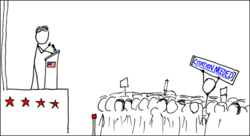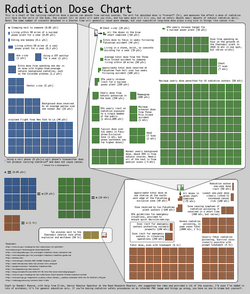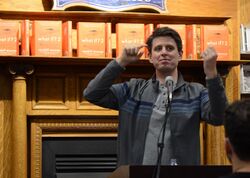Biography:Randall Munroe
Randall Munroe | |
|---|---|
 Munroe speaking at re:publica in 2016 | |
| Born | Randall Patrick Munroe October 17, 1984 Easton, Pennsylvania, U.S. |
| Alma mater | |
| Genre | Webcomics, popular science |
| Signature | |
| Website | |
| www | |
Randall Patrick Munroe (born October 17, 1984)[1][2] is an American cartoonist, author, and engineer best known as the creator of the webcomic xkcd. Munroe has worked full-time on the comic since late 2006.[3] In addition to publishing a book of the webcomic's strips, titled xkcd: Volume 0, he has written four books: What If?, Thing Explainer, How To, and What If? 2.
Early life and education
Munroe was born in Easton, Pennsylvania. His father has worked as an engineer and marketer.[4] He has two younger siblings, including a brother named Doug,[5] and was raised as a Quaker.[4][6] He was a fan of comic strips in newspapers from an early age,[3] starting with Calvin and Hobbes.[7]
After graduating from the Chesterfield County Mathematics and Science High School at Clover Hill in Midlothian, Virginia, he graduated from Christopher Newport University in 2006 with a degree in physics.[8][9][10]
Career
NASA
Munroe worked as a contract programmer and roboticist for NASA at the Langley Research Center,[11][7] before and after his graduation with a physics degree.[4]
In late 2006, he left NASA, and moved to Boston to focus on webcomics full time.[12][11]
Webcomic

Munroe's webcomic, entitled xkcd, is primarily a stick figure comic. Its tagline describes it as "A webcomic of romance, sarcasm, math, and language".[14]
Munroe had originally used xkcd as an instant messaging screenname because he wanted a name without a meaning so he would not eventually grow tired of it.[15] He registered the domain name, but left it idle until he started posting his drawings, perhaps in September 2005.[7][third-party source needed] The webcomic quickly became very popular, garnering up to 70 million hits a month by October 2007.[16] Munroe has said, "I think the comic that's gotten me the most feedback is actually the one about the stoplights".[16][17]
Munroe now supports himself by the sale of xkcd-related merchandise, primarily thousands of t-shirts a month.[3][15] He licenses his xkcd creations under the Creative Commons attribution-noncommercial 2.5, stating that it is not just about the free culture movement, but that it also makes good business sense.[15]
In 2010, he published a collection of the comics.[18] He has also toured the lecture circuit, giving speeches at places such as Google's Googleplex in Mountain View, California.[19]
The popularity of the strip among science fiction fans resulted in Munroe being nominated for a Hugo Award for Best Fan Artist in 2011 and again in 2012.[20] In 2014, he won the Hugo Award for Best Graphic Story for the xkcd strip "Time".[21]
Other projects
Munroe is the creator of the now defunct websites "The Funniest",[22] "The Cutest",[23] and "The Fairest",[24] each of which presents users with two options and asks them to choose one over the other.[citation needed]
In January 2008, Munroe developed an open-source chat moderation script named "Robot9000". Originally developed to moderate one of Munroe's xkcd-related Internet Relay Chat (IRC) channels, the software's algorithm attempts to prevent repetition in IRC channels by temporarily muting users who send messages that are identical to a message that has been sent to the channel before. If users continue to send unoriginal messages, Robot9000 mutes the user for a longer period, quadrupling for each unoriginal message the user sends to the channel.[25][third-party source needed] Shortly after Munroe's blog post about the script went live, 4chan administrator Christopher Poole adapted the script to moderate the site's experimental /r9k/ board.[26] Twitch trialed R9K mode as a beta feature,[27] and eventually introduced it under the name "unique-chat mode".[28]
In October 2008, The New Yorker magazine online published an interview and "Cartoon Off" between Munroe and Farley Katz, in which each cartoonist drew a series of four humorous cartoons.[29]
In early 2010, Munroe ran the xkcd Color Name Survey, in which participants were shown a series of RGB colors and asked to enter a suitable name for each specific color. Munroe wanted to identify colors which were given identical or highly similar names by a large number of survey participants, which would then serve as an approximate list of the most common colors rendered similarly across a range of computer monitors. Over 200,000 people eventually completed the survey,[30] and Munroe published the resulting list of 954 named RGB web colors[31] on the xkcd website. They have since been adopted as conventional color identifiers in various programming and markup languages, including Python[32] and LaTeX.[33]
In 2015, The New Yorker published "The Space Doctor's Big Idea", an article by Munroe explaining general relativity using only the 1,000 most common English words.[34]
What If?
Munroe has a blog entitled What If?, where he has answered questions sent in by fans of his comics. These questions are usually absurd and related to math or physics, and he explains them using both his knowledge and various academic sources.[35] In 2014, he published a collection of some of the responses, as well as a few new ones and some rejected questions, in a book entitled What If?: Serious Scientific Answers to Absurd Hypothetical Questions.[18] Starting in November 2019, Munroe began writing a monthly column in The New York Times titled Good Question, answering user-submitted questions in the same style as What If.[36]
A sequel, What If? 2: Additional Serious Scientific Answers to Absurd Hypothetical Questions, was published in September 2022.[37]
Radioactivity visualization

In response to concerns about the radioactivity released by the Fukushima Daiichi nuclear disaster in 2011, and to remedy what he described as "confusing" reporting on radiation levels in the media, Munroe created a radiation chart of comparative radiation exposure levels.[38] The chart was rapidly adopted by print and online journalists in several countries,[citation needed] including being linked to by online writers for The Guardian ,[39] and The New York Times.[40] As a result of requests for permission to reprint the chart and to translate it into Japanese, Munroe placed it in the public domain, but requested that his non-expert status be clearly stated in any reprinting.[41]
Munroe published an xkcd-style comic on scientific publishing and open access in Science in October 2013.[42]
Thing Explainer
Munroe's book Thing Explainer, announced in May 2015 and published later that year, explains concepts using only the 1,000 most common English words.[18][43][44] The book's publisher, Houghton Mifflin Harcourt, saw these illustrations as potentially useful for textbooks, and announced in March 2016 that the next editions of their high-school-level chemistry, biology, and physics textbooks will include selected drawings and accompanying text from Thing Explainer.[45][46]
How To
In February 2019, Munroe announced his next book, How To, which was released in September of that year. The book deals with everyday problems by using physics to find absurd, and generally extreme, solutions to them.[47][6]
YouTube
On 31st August 2023, Munroe created a YouTube channel called xkcd's What If?, where he first uploaded on 29th November of the same year. On the channel Munroe answers questions from the How To book series, accompanied by xkcd-style animations.[48]
Influence
In September 2013, Munroe announced that a group of xkcd readers had submitted his name as a candidate for the renaming of asteroid (4942) 1987 DU6 to 4942 Munroe. The name was accepted by the International Astronomical Union.[49][50]
Personal life
(As of May 2008), Munroe lives in Somerville, Massachusetts.[3]
In October 2010, Munroe's fiancée was diagnosed with stage three breast cancer; there had been no prior family history.[51][52] The emotional effect of her illness was referenced in the comic panel "Emotion", published 18 months later in April 2012.[53] In September 2011, he announced that they had married.[54] In November 2012, he published a comic entitled "Two Years", and in December 2017, Munroe followed this with a comic entitled "Seven Years".[55] He revisited the subject in November 2020 in a comic entitled "Ten Years".[56]
His hobbies and interests include kite photography, in which cameras are attached to kites and photographs are then taken of the ground or buildings.[57]
Publications
Publications by Munroe
- xkcd: volume 0. Breadpig. 2009. ISBN 9780615314464. https://archive.org/details/2009Xkcd.
- What If?: Serious Scientific Answers to Absurd Hypothetical Questions. London: John Murray. 2014. ISBN 9781848549579. https://archive.org/details/whatifserioussci0000munr_n0l4.
- Thing Explainer. Boston: Houghton Mifflin Harcourt. 2015. ISBN 9780544668256. https://archive.org/details/thingexplainerco00unse.
- How To: Absurd Scientific Advice for Common Real-World Problems. John Murray. 2019. ISBN 9780525537090. https://archive.org/details/how-to-absurd-scientific-advice-for-common-unknown.
- What If? 2: Additional Serious Scientific Answers to Absurd Hypothetical Questions. Riverhead Books. 2022. ISBN 9780525537113. https://archive.org/details/what-if-2-randall-munroe.
Publications with contributions by Munroe
- North, Ryan; Matthew, Bennardo; Malki, David (2010) (in en). Machine of Death. ISBN 9780982167120. http://machineofdeath.net/pdf/MachineofDeath_FINAL.pdf.
References
- ↑ Chamberlin, Alan. "JPL Small-Body Database Browser". https://ssd.jpl.nasa.gov/sbdb.cgi?sstr=4942.
- ↑ Cavna, Michael (September 12, 2022). "The world's funniest former NASA roboticist will take your questions". The Washington Post. https://www.washingtonpost.com/comics/2022/09/12/randall-munroe-xkcd-what-if/.
- ↑ 3.0 3.1 3.2 3.3 Cohen, Noam (May 26, 2008). "This Is Funny Only if You Know Unix". The New York Times. ISSN 0362-4331. https://www.nytimes.com/2008/05/26/business/media/26link.html?partner=rssnyt&emc=rss.
- ↑ 4.0 4.1 4.2 Tupponce, Joan (November 24, 2009). "A Cartoonist's Mind" (in en-us). https://richmondmagazine.com/news/a-cartoonists-mind-11-24-2009/.
- ↑ "Pillar". https://xkcd.com/32/.
- ↑ 6.0 6.1 Martinelli, Marissa (September 6, 2019). "Xkcd Creator Randall Munroe on the Joys of Overthinking Everything". https://slate.com/culture/2019/09/xkcd-randall-munroe-interview-how-to-book-wikipedia.html.
- ↑ 7.0 7.1 7.2 Munroe, Randall (December 11, 2007). Authors@Google: Randall Munroe (@Google Talks Adobe Flash video). Mountain View, California: Google. Event occurs at 24:13, 48:05, other timepoints. Archived from the original on 2021-12-19. Retrieved September 25, 2008.
...Calvin and Hobbes was the first comic that I discovered. / ... I'm pretty sure I started [posting drawings] in September 2005
- ↑ Munroe, Randall. "About". xkcd. http://xkcd.com/about/.[third-party source needed]
- ↑ Munroe, Randall (October 6, 2006). "Many news things, some overdue". WordPress. Job. http://blog.xkcd.com/2006/10/06/many-news-things-some-overdue/. "My about page mentions that I work for NASA — I'm technically a contractor working repeated contracts for them. However, they recently ran out of money to rehire me for another contract, so I'm done there for now."[third-party source needed]
- ↑ "Voyages 2012". December 2014. https://issuu.com/cnuocpr/docs/voyages_2012.
- ↑ 11.0 11.1 Lineberry, Denise (2012). "Robots or Webcomics? That was the Question". NASA. http://www.nasa.gov/centers/langley/news/researchernews/rn_xkcd.html.
- ↑ Harvkey, Mike (August 5, 2019). "Cartoonist Randall Munroe Will Be Your Answer Man". Publishers Weekly 266 (31): p. 49. ProQuest 2268106353. https://www.proquest.com/docview/2268106353.
- ↑ Munroe, Randall. "Wikipedian Protester". http://xkcd.com/285/.
- ↑ Munroe, Randall. "xkcd". https://xkcd.com/2263/.
- ↑ 15.0 15.1 15.2 Fernandez, Rebecca (October 12, 2006). "xkcd: A comic strip for the computer geek". Red Hat Magazine (Raleigh, North Carolina: Red Hat). http://www.redhat.com/magazine/025nov06/features/xkcd/.
- ↑ 16.0 16.1 So, Adrienne (November 13, 2007). "Real Geek Heart Beats in Xkcd's Stick Figures". Wired (San Francisco, California: Condé Nast Publications). ISSN 1059-1028. https://www.wired.com/entertainment/theweb/news/2007/11/xkcd. Retrieved September 25, 2008.
- ↑ Randall Munroe (June 15, 2007). "Long Light". xkcd. https://xkcd.com/277/.
- ↑ 18.0 18.1 18.2 Alter, Alexandra (November 23, 2015). "Randall Munroe Explains It All for Us". The New York Times. https://www.nytimes.com/2015/11/24/books/randall-munroe-explains-it-all-for-us.html.
- ↑ Spertus, Ellen (December 21, 2007). "Randall Munroe's visit to Google (xkcd)". Beyond Satire. http://www.beyondsatire.us/?q=node/272.
- ↑ Hugo Staff. "Hugo Awards 2012 nomination". http://www.thehugoawards.org/hugo-history/2012-hugo-awards/.
- ↑ Hugo Staff (April 18, 2014). "Hugo Awards 2014 nomination". http://www.thehugoawards.org/hugo-history/2014-hugo-awards/.
- ↑ Munroe, Randall. "The Funniest". http://thefunniest.info.
- ↑ Munroe, Randall. "The Cutest". http://thecutest.info.
- ↑ Munroe, Randall. "The Fairest". http://thefairest.info.
- ↑ Munroe, Randall (January 14, 2008). "ROBOT9000 and #xkcd-signal: Attacking Noise in Chat". blog.xkcd.com. https://blog.xkcd.com/2008/01/14/robot9000-and-xkcd-signal-attacking-noise-in-chat/.
- ↑ Petersen, Kierran (October 2, 2015). "A short history of /r9k/ — the 4chan message board some believe may be connected to the Oregon shooting". Public Radio International. https://www.pri.org/stories/2015-10-02/short-history-r9k-4chan-message-board-some-believe-may-be-connected-oregon. "Surprisingly enough, however, the /r9k/ board, otherwise known as ROBOT9001, was originally conceived as a way to increase the quality of messages on the wildly popular webcomic xkcd. It used a type of auto-moderation that prevented people from posting the same comment multiple times. [...] 4chan eventually moved the idea and software behind ROBOT9000 on to its site. They just added a one."
- ↑ "What Does R9K Mode Mean - Twitch - Streamer Tactics" (in en-us). 2022-09-30. https://streamertactics.com/r9k-mode-meaning/.
- ↑ "Twitch Unique Chat Mode - Twitch - Streamer Tactics" (in en-us). 2022-11-18. https://streamertactics.com/twitch-unique-chat-mode/.
- ↑ Katz, Farley (October 15, 2008). "Cartoon-Off: XKCD". The New Yorker. https://www.newyorker.com/cartoons/the-cartoon-lounge/cartoon-off-xkcd.
- ↑ "Color Survey Results" (in en). 2010-05-04. https://blog.xkcd.com/2010/05/03/color-survey-results/.
- ↑ "954 most common RGB colors (xkcd color survey results)". https://xkcd.com/color/rgb/.
- ↑ "Specifying colors - Matplotlib 3.7.0 documentation". https://matplotlib.org/stable/tutorials/colors/colors.html#color-formats.
- ↑ "CTAN: Package xkcdcolors". https://www.ctan.org/pkg/xkcdcolors.
- ↑ Munroe, Randall (November 18, 2015). "The Space Doctor’s Big Idea". https://www.newyorker.com/tech/annals-of-technology/the-space-doctors-big-idea-einstein-general-relativity.
- ↑ "What If? Serious Scientific Answers to Absurd Hypothetical Questions". https://www.goodreads.com/work/best_book/40714465-what-if-serious-scientific-answers-to-absurd-hypothetical-questions.
- ↑ "Good Question". The New York Times. https://www.nytimes.com/column/good-question-randall-munroe-xkcd.
- ↑ Gartenberg, Chaim (31 January 2022). "XKCD's Randall Munroe announces What If? 2, with more scientific answers to life's most absurd hypothetical questions". https://www.theverge.com/2022/1/31/22910603/xkcd-randall-munroe-what-if-2-book-annoucement-release-date.
- ↑ "Radiation dosage chart". xkcd.com. https://xkcd.com/radiation/.
- ↑ Monbiot, George (March 21, 2011). "Why Fukushima made me stop worrying and love nuclear power". The Guardian (London). https://www.theguardian.com/commentisfree/2011/mar/21/pro-nuclear-japan-fukushima.
- ↑ Revkin, Andrew (March 23, 2011). "The 'Dread to Risk' Ratio on Radiation and other Discontents". Dot Earth blog (The New York Times). http://dotearth.blogs.nytimes.com/2011/03/23/the-dread-to-risk-ratio-on-radiation-and-other-discontents/?hp.
- ↑ Munroe, Randall (March 19, 2011). "Radiation Chart". www.xkcd.com. http://blog.xkcd.com/2011/03/19/radiation-chart/.
- ↑ Munroe, Randall (October 4, 2013). "The Rise of Open Access". Science 342 (6154): 58–59. doi:10.1126/science.342.6154.58. PMID 24092724. Bibcode: 2013Sci...342...58..
- ↑ Kastrenakes, Jacob (May 13, 2015). "XKCD has a new book about explaining complicated subjects in simple ways". https://www.theverge.com/2015/5/13/8597607/xkcd-thing-explainer-book-announced.
- ↑ Alderman, Naomi (December 17, 2015). "Thing Explainer: Complicated Stuff in Simple Words by Randall Munroe – funny, precise and beautifully designed". The Guardian. https://www.theguardian.com/books/2015/dec/17/thing-explainer-complicated-stuff-simple-words-randall-munroe.
- ↑ Chang, Kenneth (March 22, 2016). "Randall Munroe, XKCD Creator, Goes Back to High School". New York Times. https://www.nytimes.com/2016/03/22/science/randall-munroe-xkcd-science-textbook.html.
- ↑ Jao, Charline (March 23, 2016). "XKCD Creator Randall Munroe Making Content For High School Textbooks". http://www.themarysue.com/xkcd-textbook/.
- ↑ Munroe, Randall. "how to". https://xkcd.com/how-to/.
- ↑ "xkcd's What If?". https://www.youtube.com/@xkcd_whatif.
- ↑ "4942 Munroe (1987 DU6)". NASA Jet Propulsion Laboratory, California Institute of Technology. July 29, 2013. http://ssd.jpl.nasa.gov/sbdb.cgi?sstr=4942.
- ↑ Munroe, Randall (September 30, 2013). "Asteroid 4942 Munroe". http://blog.xkcd.com/2013/09/30/asteroid-4942-munroe/.
- ↑ Munroe, Randall (November 5, 2010). "November - 2010 - xkcd". https://blog.xkcd.com/2010/11/.
- ↑ Munroe, Randall (June 30, 2011). "Family Illness". https://blog.xkcd.com/2011/06/30/family-illness.
- ↑ Munroe, Randall. "xkcd: Emotion". https://xkcd.com/1048/.
- ↑ Munroe, Randall (September 12, 2011). "<3". Blog. XKCD. http://blog.xkcd.com/2011/09/12/672/.
- ↑ Munroe, Randall (December 13, 2017). "Seven Years". Webcomic. XKCD. https://xkcd.com/1928/.
- ↑ Munroe, Randall (November 16, 2020). "Ten Years". Webcomic. XKCD. https://xkcd.com/2386/.
- ↑ Kuchera, Ben (July 2, 2007). "The joys of kite photography". Ars Technica. https://arstechnica.com/gaming/news/2007/07/the-joys-of-kite-photography.ars.
External links
 |


